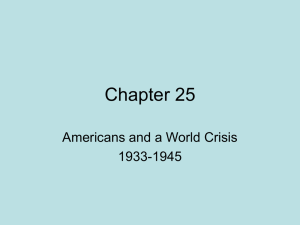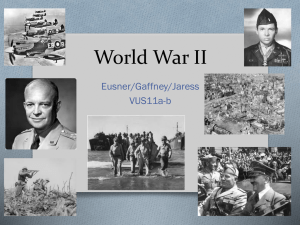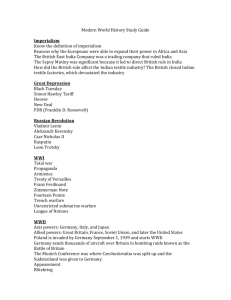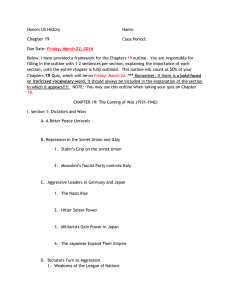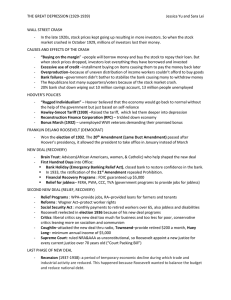ERA 8.2 * WWII (1939-1945)
advertisement
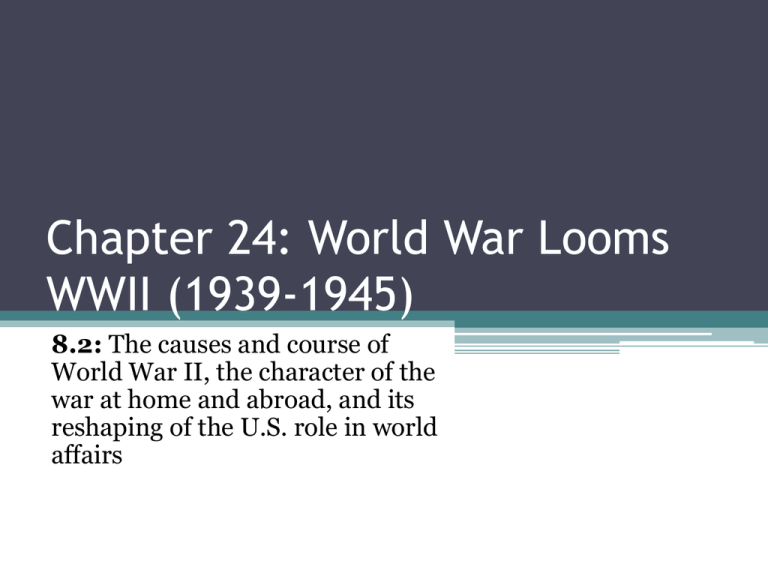
Chapter 24: World War Looms WWII (1939-1945) 8.2: The causes and course of World War II, the character of the war at home and abroad, and its reshaping of the U.S. role in world affairs Road To WWII • Totalitarianism – Total control over every aspect of citizen’s lives • - a form of dictatorship • Totalitarian governments gained power in Europe in the 1930’s • Fiction vs. Reality Protesting Totalitarianism in Today’s World- Thailand 2014 • https://www.youtube.com/watch?v=0Iet_QkuU Gs • https://www.youtube.com/watch?v=OOI7gejQcj I Political Philosophies • 1. Communism• a society without class distinctions or private property (equality?) • state has absolute authority • • • • 2. Fascism1 political party state has absolute authority Unlike communism, defends private property and social classes • People do not have right to free speech! Political Philosophies • 3. Democracy – a system of government in which • the people have the power to rule, either directly or indirectly • through their elected officials • Example of a Democratic Government: • The United States • FREEDOM of speech, press, religion • Right to vote and elect political leaders • Many political parties to choose from Political Philosophies • Communist & Fascist regimes are examples of Totalitarianism • Examples: • Soviet Union – Communist (1920’s-1991) • Italy & Germany – Fascist (1930’s – 1945) Totalitarian Rulers Around the World 1930’s-1940’s • 1. Benito Mussolini – (Italy) fascist/military • 2. Adolf Hitler – (Germany) gains power 1933. Fascist/military • 3. Joseph Stalin – Soviet Union (Communist) • 4.Japanese Military dictatorship 1930’s • Fascist/Military Anti-Comintern Pact, 1937 • Alliance formed Between: Germany, Italy, Japan • They pledge to oppose international communism • Join forces against the Soviet Union ( & the spread of communism) Nazi- Soviet Pact, 1939 • But then… • Hitler (Germany) signed non-aggression pact with Stalin (Soviet Union )! • They agreed Not to invade/ attack each other Section 2: War in Europe WWII Explained in Seven Minutes • https://www.youtube.com/watch?v=wvDFsxjaP aE Events Leading Up to WWII • Hitler invaded: • 1.Rhineland, 1936 • Region between Germany & France • 2. Austria 1938 • 3. Sudetenland 1938 (Czechoslovakia) • Why?? WWII Officially Began When… • Hitler & his German Troops invaded • Poland Sept. 1st, 1939 • Great Britain & France declared war on Germany Why Didn’t Anyone Stop Hitler Prior To Sept. 1st 1939? • The “Appeasement” Policy: • Allowing aggressors to have what they want… • In the hope they will demand no more Sides & Alliances • • • • • ALLIES: 1. Great Britain 2. France 3. U.S. (joined 1941) 4. Soviet Union (joined 1941 After Hitler betrayed Stalin) • • • • AXIS POWERS: 1. Germany 2. Italy 3. Japan 1940-German Troops… • Invaded Northern European countries: • Denmark, Norway May, 1940- Hitler & German Troops • Invaded France May 10, 1940 • France surrendered on June 22, 1940 • Defeat of France shocked the world August 1940-Battle of Britain • German planes bombed Great Britain Aug. 1940 • 1 night 70,000 fire bombs dropped • Massive destruction • Great Britain Defeated the German air force (Luftwaffe) …barely After the Battle of Britain, 1940 • Winston Churchill (British Prime Minister) asked American President Franklin Roosevelt for help • Did the U.S. Join the war at this point??? Yes, This is a WWII Reference • https://www.youtube.com/watch?v=FrHkKXFR bCI Section 4: America Moves Towards War American “Neutrality” Since 1939 • Neutrality Act of 1939 • U.S. neutrality in name, not in deed. • Allowed for sale of American weapons/ supplies to European allies on a • “Cash-and-Carry” basis – Great Britain had to travel to U.S. pick up supplies, pay in cash “Destroyers for Bases” Deal, 1940 • U.S. provided Great Britain with older naval ships (50) • In return, • U.S. gained rights to establish military bases in British held Caribbean islands American President Franklin D. Roosevelt • Franklin D. Roosevelt ran for 3rd term (1940) • Won 54% of popular vote • “better a third term than a third rater” Roosevelt’s Address to Congress (1940) • To Protect “4 Freedoms” • 1. Freedom of Speech • 2. Freedom of Religion • 3. Freedom of Want • 4. Freedom of Fear Lend Lease Act, 1941 • Franklin D. Roosevelt & British Prime Minister Winston Churchill met secretly • U.S. let Great Britain borrow war supplies Churchill & FDR also signed the… • Atlantic Charter, 1941 • The Cornerstones of a world free of fascism include… • 1. Self determination of people • 2. Free trade • 3. disarmament • U.S. & Great Britain share political ideologies Question!! • Has the United States joined World War II yet?? • When will the U.S. join WWII? Why? 1941- Operation Barbarossa • Hitler Betrayed Stalin! • And invaded the Soviet Union in June! • Soviet Union officially joined the allies - 1941 1941 – The Holocaust • 1941 – extermination of Jews, people of color, Gypsies, Clergy, disabled, opponents of Hitler’s regime • Gestapo = secret police arrest Hitler’s opponents Concentration Camps • 1941-1942: Jews from all over Europe transported to concentration camps • 6 million Jews Killed • 6 Million Non- Jews Killed CLARIFICATION • WWII began Sept. 1st, 1939 • Germany (Hitler) acted as the aggressor and invaded various countries throughout Europe. • Meanwhile, Japan acted as an aggressor and invaded various countries in Asia. *** Japan Invaded its Neighbors 1. Conquered Manchuria 1931 2. Invaded China 1937 Nanking- 200,000 Chinese citizens killed 3. Invaded Indo-China (Vietnam) Tripartite Pact – Formal Alliance of Axis Powers • 1940 An Alliance between Germany, Japan, Italy In response to Japanese Aggression… President Roosevelt • U.S. refused to trade with Japan • Froze Japanese assets in U.S. • Restricted oil exports to Japan • Placed an embargo on sale of scrap iron to Japan In Retaliation, Japan Planned a Secret Attack on American Territory America the Story of Us; WWII • Pearl Harbor to 9:45 1941- Pearl Harbor, Hawaii • December 7, 1941 • Japanese planes attacked American Naval fleet • 2,400 died • 1,200 wounded Pearl Harbor-Statistics • 8 Battleships sunk • 10 other ships damaged • Including the U.S.S. Arizona • 200 planes destroyed Why Pearl Harbor, Hawaii? Why Pearl Harbor? • Key American military base in the Pacific • Dec. 8 : President Roosevelt/Congress declared war on Japan • Dec. 11: Germany & Italy declared war on U.S. Franklin D. Roosevelt… • “Yesterday, December 7th,1941… a date which will live in infamy” - FDR Section 1: Mobilizing for Defense ****1941- 1945***** Executive Order #9066 • “… the successful prosecution of the war requires every possible protection against espionage and against sabotage to national-defense material, nationaldefense premises, and national-defense utilities…” – Feb. 1942 Executive Order 9066 • Feb 19, 1942 • 100,000 people of Japanese descent (Nisei) On West Coast • Removed from homes • Placed in “Internment camps” Japanese Internment Japanese Internment • A Civil Rights infringement? • Was the decision to intern all people of Japanese descent in the West coast justified? Japanese Internment- Justified? • More 60% were U.S. citizens • 1/3 under the age of 19 Re: Japanese Internment • “I was born in Hawaii. I worked most of my life on the West Coast. I have never been to Japan. We would have done anything to show our loyalty. All we wanted to do was to be left alone on the coast. . . . My wife and I lost $10,000 in that evacuation. She had a beauty parlor and had to give that up. I had a good position worked up as a gardener, and was taken away from that. We had a little home and that’s gone now. . . .” – anonymous “older Nisei”, 1943 (Manzanar) Korematsu vs. United States (1944) • RE: Japanese Internment • Supreme Court decided that in times of war, the curbing of civil rights is justified. • 1988 U.S. government formally apologized paid surviving families $20,000 Santa Anita Racetrack, Arcadia CA • Used as an “assembly center” Japanese Arriving at Santa Anita Santa Anita Racetrack – over 3,000 Internees Economic Impact of War in U.S. • 1. War Industry/ Defense Jobs • End of the economic depression as jobs became available • 2. “Bracero Program” 1942- 200,000 Mexican farm workers were recruited to work in agriculture • 3. Movement of People: 8 million people moved West of the Mississippi 1940-1950 Native American “Code Talkers” • “code talkers” used NativeAmerican languages • to encode & decipher secret messages • Employed by every branch of the military “Rosie the Riveter” – Women & Work • Women recruited to work in war industries • 6 million women entered the job force • Contributed to the war effort by producing weapons, supplies, etc. “Rosie “ at Work America the Story of Us; WWII • Women at work 9:46-19:00 Women in the Military • 260,000 women volunteered for military service • 1.Women’s Army Corp (WACs) • 2.Women Appointed for Voluntary Emergency Service (WAVES) Women in the Military • 3.Women’s Auxiliary Ferrying Squadron (WAFs) • Female pilots • Team of 28 • Transported soldiers & light aircraft Women in the Military • 4. U.S. Cadet Nurse Corps • 20 nursing schools in the country • Government paid training Section 2: The War for Europe and North Africa *** “Operation Overlord” • Turning point in war! • 176,000 Allied Soldiers • British, Canadian, American Troops • 600 warships, 10,000 aircraft • Landed in…Normandy, France • Also known as “DDAY” Why is D-DAY Significant? • June 6, 1944 • Victory for Allies • Launched “amphibious” attack against German army • Allies won – German forces retreated August 25 America the Story of Us- WWII • D-DAY 27:00 – 39:00 Allies Liberated France from German control - 1944! Battle of the Bulge - 1944 • December, 1944 • Allied Forces continued towards Belgium • Faces defensive attack by German forces Yalta Conference -Feb. 1945 • “The Big 3” • 1. Franklin D. Roosevelt (U.S.) • 2. Winston Churchill (G.B.) • 3. Joseph Stalin (Soviet Union) • Discussed postwar aftermath “The Big Three” • Agreed to divide Germany 4 Zones: • Soviets would control east, • U.S., Great Britain, France would control western Germany • Berlin, Germany = joint occupation • Germany to pay $20 billion in war reparations Spring, 1945 • American President Franklin D. Roosevelt • Died Suddenly April, 1945 • V.P. Becomes President – Harry S. Truman Spring, 1945 • Allies liberated Concentration camps May, 1945 • Hitler committed suicide on April 30, 1945 • Nazis surrendered May 7, 1945 • Was this the end of the WWII??? Section 3: The War in the Pacific Top Secret Manhattan Project • Harry S. Truman ( American President) • Considered using the top secret weapon • The Atomic Bomb Top Secret Manhattan Project • $2 million top secret American nuclear weapon experiment • First “A-bomb” tested July, 16 1945 • In southwestern desert America the Story of Us-WWII • A –bomb 39:35- to end President Truman’s Choice • Ordered military to drop A-Bomb on Japan • If they didn’t surrender by August 3. August 6, 1945 • B-29 bomber airplane called Enola Gay • Dropped 5 ton uranium bomb (“little boy”) • Hiroshima, Japan • 80,000 people killed • 60,000 more died radiation by the end of the year August 9, 1945 • Second bomb dropped (“ Fat man”) in • Nagasaki, Japan • Another 60,000 people died • Japan surrendered September 2, 1945 The Bombing of Hiroshima & Nagasaki • Necessary to end the war? • Why is this still considered a controversial decision ?? WWII Aftermath… • 55-60 Million People died during WWII • Half were civilians (Holocaust, Atomic bomb) • How much is a population of 60 million?? 2010 Population in California : 38 Million • “Crimes against humanity” entered vocabulary – refers to atrocities committed by Nazis • WWII Officially ended : September 1945 After WWII… Impact on American Economy • 1. End of Great Depression • Increase in productivity (manufacturing) • Full employment • The Iconic Photograph… • https://www.youtube.com/watch?v=JPLuecUvb Rc • https://www.youtube.com/watch?v=4pjHKxG2 MO8 New Technology Introduced During WWII • • • • • 1. radar 2. computers 3. electronics 4. rockets 5. Nuclear Weapons (atomic bomb) Opportunities for Women, Minorities • 1. Women entered job force • 2. Desegregation of armed forces AFTER the war • 3. Native American Code talkers • 4. Bracero program – Mexican farm workers recruited Impact on American Life • G.I. Bill : also known as the “Servicemen’s Readjustment Act” • WWII Veterans are rewarded • 1. College scholarships • 2. home loans • 3. small business loans Two World Powers Emerged … • 1. The United States • And… • 2. The Soviet Union •
